-
Paper Information
- Next Paper
- Previous Paper
- Paper Submission
-
Journal Information
- About This Journal
- Editorial Board
- Current Issue
- Archive
- Author Guidelines
- Contact Us
Management
p-ISSN: 2162-9374 e-ISSN: 2162-8416
2014; 4(3A): 12-20
doi:10.5923/s.mm.201401.02
Mobile Tagging in German Magazines: A One-Year Study of QR Code Usage in Top-Selling Mass Market Publications
Stephan Böhm, Daniela Ruthardt
Department of Design and Computer Science, Rhein Main University of Applied Sciences, Wiesbaden, 65195, Germany
Correspondence to: Stephan Böhm, Department of Design and Computer Science, Rhein Main University of Applied Sciences, Wiesbaden, 65195, Germany.
| Email: |  |
Copyright © 2014 Scientific & Academic Publishing. All Rights Reserved.
In the last decade, media consumption has shifted from traditional printed publications towards online media. This is why publishing companies are forced to develop innovative cross- and multi-channel strategies to protect revenues and to prevent further customer churn. Such strategies can be implemented on the basis of mobile tagging. Mobile tags such as QR codes have been used in German mass market publications for quite some time. Although the general usage and user acceptance of mobile tagging has already been subject to research, studies are still lacking on company use of mobile tags in mass market publications. Against this background, this paper presents a longitudinal study on the application of QR code technology in the 2012 issues of ten top-selling German popular magazines. The results of the study indicate that company usage of QR codes increased by 140 percent in 2012. The application of QR codes is dominated by commercial purposes such as advertisements. Editorial usage is mostly limited to popular news magazines but seems to have an impact on the usage intensity of commercial tagging. Best practices for QR codes integration, such as the usage of deep links, were observed for the majority of the analysed case studies. On the other hand, the study has revealed room for improvement.
Keywords: Mobile Tagging, QR Codes, Cross Media Strategies, Popular Magazines
Cite this paper: Stephan Böhm, Daniela Ruthardt, Mobile Tagging in German Magazines: A One-Year Study of QR Code Usage in Top-Selling Mass Market Publications, Management, Vol. 4 No. 3A, 2014, pp. 12-20. doi: 10.5923/s.mm.201401.02.
Article Outline
1. Introduction
- The print media industry is currently being challenged by emerging technologies, demographic change and a shift in media consumption from print to online technologies. Digitization of media and ubiquitous access to the Internet have established new channels for content distribution and caused an ongoing expansion of online content [1–3]. As a result, usage of traditional media, such as TV, radio and print media, is dwindling. This decline also affects the circulation figures of newspapers and magazines which have been sinking continuously for years. The decrease in circulation, in turn, leads to a drop in sales revenue from advertising, which had until recently constituted 40 to 60% of overall revenue of such print products [4]. In the face of these developments, newspaper and magazine publishers have been forced to rethink their existing formats and business models and are already reacting by gradually integrating online and mobile channels into their business models. One approach is “Cross Media Publishing”, by which contents are delivered using various channels and by including the use of new technologies [5, 6]. The use of such technologies also enables the transition from classic print and offline worlds to modern online platforms. Mobile tagging is an approach which creates such a link between print and online and is thereby able to bridge the gap between magazines and additional online information.Mobile tags are two-dimensional (2D) barcodes that can be decoded with camera-equipped mobile devices [7, 8]. These tags can be added to newspapers and magazines to provide access to supplementary editorial or commercial content. In print media, so-called Quick Response (QR) codes are commonly used for this purpose [9]. These codes are decoded using a special reader software and a smartphone camera. If a link (i.e., a URL) is embedded in a QR code, access to further information on the Internet can be provided via the reader’s smartphone.Mobile tagging thereby enables publishers to develop new cross media publishing strategies and to offer added-value for the target groups of readers and advertisers which can be put to commercial use. The advantages of static print versions (sensory appeal, structured presentation and mobility) can be combined with the wealth of information, topicality and interactivity of the Internet. In terms of editorial content for example, usage of QR codes makes it possible to offer new and additional information to articles even if they have already been printed and published. The tags can also be used to provide additional information for which there was insufficient space in the print article or to enrich an article with multimedia contents. Based on these capabilities of mobile tags, the publishers can integrate new media elements and implement a value driven customer retention strategy for their traditional print publications. Besides linking the QR codes with editorial content, there is also potential for commercial use. This ranges from an online extension of traditional print advertisements to advanced customer acquisition and retention strategies (e.g. voucher campaigns) and finally to linking advertising to concrete purchase and ordering options in mobile commerce.In this regard, QR codes can be seen as an interactive mobile advertising tool: They enable a greater degree of connectivity to the customers and thus can strengthen the customer relationship. Offline audiences can be converted into online relationships or active buyers by using mobile tags as a call to action for immediate response towards the advertising message. In addition, QR codes offer advanced opportunities to evaluate consumer interests and response rates of advertising campaigns [10]. Regardless of their technical capabilities, QR codes can also be used as a “Key Visual” with the objective of transporting an innovative brand image. However, if the QR code is not linked to real added value, such effects will be short-lived or even turn out to be counterproductive in the long term.Mobile tagging as described above has been used for quite some time in German magazines and its dissemination in the print industry has increased over the last few years. In general, according to a recent study among German companies, 88 percent of large German enterprises have already used mobile tagging and 64 percent have been using this technology for two years or less. The lack of experience with mobile tagging is probably also one of the reasons for the fact that only 6 percent of this study’s respondents stated that mobile tagging was of high importance for their companies and only 4 percent had a defined mobile tagging strategy [11]. Recent studies on the user acceptance of mobile tagging indicate that most smartphone users are aware of QR codes but only a minority is using this technology on a regular basis [12]. In international literature, the use of QR codes in magazines has been studied [13, 14], but more comprehensive analysis on the German market is still missing so far.Against this background, a longitudinal study on the application of QR code technology by German publishers was conducted in the paper at hand to answer the following research questions:1. What is the status quo and the trend for QR code integration in German popular magazines?2. What is the purpose of QR code integration?3. What type of content is linked with the codes?4. Does the integration of QR codes comply with common best practices?The analysis was based on the 2012 issues of the ten top-selling German popular magazines. Our research paper has five sections. Following this introduction, Section 2 discusses the research background with regard to the situation in the German magazine market and best practices for the application of QR codes in print media. The research objectives and methodology of the longitudinal study are presented in Section 3. The article continues with some selected findings of our study and its interpretation in Section 4. The article concludes with a summary of the findings and implications for further research in Section 5.
2. Research Background
2.1. Situation of the German Magazine Market
- The term “print media” is commonly used to describe media whose final product is made of paper and includes books, newspapers and magazines. Popular periodical print media for the mass market are newspapers and magazines. Newspapers are those publications which appear at least twice a week. The content represents current topics, not limited to a specific issue, so that the categories politics, economics, culture, entertainment, current events and sport always exist independently of the specific newspaper.Magazines, on the other hand, are those publications, which appear at least four times a year and therefore do not have to be published in a weekly cycle. The topicality of the represented information is less than that of the newspaper. In addition, magazines cover specific target groups and focus on content to meet the interests of the respective readership [4]. Magazines that address mass markets within the segment of non-professionals and aim to satisfy readers’ needs for information, entertainment and recreation are referred to as popular magazines (“Publikumszeitschriften”) [15]. These popular magazines can be divided into general interest and special interest titles. While the former are aimed at a very wide audience and typically include information on politics, economics, current events, culture, entertainment and sport, the latter focus on easily understandable information and entertainment elements for a more specific topic or narrower target group.Popular magazines are also affected by the general decline of print media discussed in the introduction. Between the fourth quarters of 2003 and 2013, the average monthly circulation of popular magazines in Germany fell from 125 to 105 million, thereby declining by around 16 percent [16]. In contrast, the number of popular magazine titles in Germany has increased continuously over the last few years. Between 2003 and 2013, the number of magazines with at least quarterly publication increased by 321 titles. This development was particularly driven by the rising number of special interest titles. It can be assumed that this was a strategy the publishers followed to strengthen their position in the market by better covering the readers’ need for information on specialised topics and also offering advertisers media in order to address their relevant target groups more effectively [17, 18].Readers of popular magazines are already accustomed to using the digital versions of the magazines. According to a 2012 study of the German magazine publishers’ association VDZ, popular magazines have already attained the widest coverage in terms of own online and mobile services compared to newspapers, radio and TV [18]. As far as mobile media technologies are concerned, the integration of mobile tagging or QR codes in popular magazines is certainly its most clearly visible implementation, besides image recognition and augmented reality apps. Despite this fact however, hardly any research or empirical studies have been carried out yet in order to investigate the use of QR codes in this magazine segment in more detail.
2.2. Best Practices of QR Code Integration
- Despite the wide range of possible uses, the increasing number of smartphones and the widespread coverage for mobile Internet as a basic infrastructure, mobile tagging in Germany is currently still nowhere near achieving a breakthrough into the mass market [12]. As discussed before, the usage of QR codes is significantly smaller than the awareness and presence of QR codes in public areas and the number of users equipped with suitable mobile devices. This is due to barriers to usage such as the fact that reader software is not usually pre-installed on smartphones or that the benefits of scanning QR codes are often not immediately recognisable for users [19]. In addition, unsatisfactory usage experiences may also hamper the further development of mobile tagging. This is because the use of QR codes is often not sufficiently thought out, and, as mentioned earlier, is often aimed at offering an innovative design element rather than using this technology in a way which adds value for the users. In these cases, QR codes are connected to websites which have not been optimised for mobile devices for example or which only offer redundant information already contained in the corresponding print medium.These problems can be avoided, however, if some basic rules or “Best Practices” are considered. These recommendations are simple technical and content-related rules for the application of QR codes and can be assumed to be generally known in professional circles involved in Mobile Tagging. This is reflected in the variety of best practice guidelines available online (e.g., [20–23]) which includes the important recommendations compiled below:• Mobile optimised targets: QR codes must link to content that is optimised for mobile devices.• Usage of deep links: Encoded links must lead directly to the relevant information.• Add value: The user must be able to recognise an immediate benefit after scanning the code.• Call to action: The user needs to know what to expect after scanning the codes.• Allow for quick scanning: Reduce code complexity by minimising the number of encoded characters.• Proper positioning: The code must be placed in the print medium, to allow for convenient scanning.• Adequate sizing: The scaling of the QR code has to take normal magazine reading distance into consideration.• Preserve robustness: Avoid unnecessary design changes of QR codes (e.g., logo, rounded corners).• Test code integration: Testing of the integrated QR codes in the page layout based on a page proof.• Code tracking: Analyse server requests triggered by code scans to determine response rates.The first four criteria are directly connected to customer value and the user experience. Scanning the code only makes sense if the user can directly retrieve the linked contents on the mobile device and if this procedure adds value in the context of mobile usage. As this is not immediately recognisable via the image of the QR code alone, additional instructions for use are necessary, which point out the expected results of the scanning process and communicate the resulting added benefits in order to motivate the user (e.g., “scan the code to watch the video”).The following four criteria are more related to technical features of the QR codes and influence the usability of mobile tagging. These criteria are often ignored when QR codes are merely being used as a design element in print media. If, for example, more than 60 characters are embedded in a QR code, the rate and speed of recognition may be significantly impacted, depending on the mobile device. Therefore, redirects and URL shorteners should be used in order to reduce the number of characters. QR codes should be positioned in the layout of the print media to ensure recognisability and to facilitate scanning. Furthermore, the positioning of the medium itself in terms of scan distance and angle as well as lighting conditions and network coverage availability has to be considered. As far as the sizing of the QR code is concerned, the relation between the scan distance and the required size of the QR code must be taken into consideration. As a rule of thumb, the ratio of scan distance to code size can be taken as being 10:1 [24]. A scan distance of 20 cm therefore results in a QR code size of around 2 cm. Correspondingly, a QR code on a poster or placard must be larger, as we must assume a much larger scan distance. Similarly to the integration of a large number of characters, a change in the QR codes’ design can significantly impact the robustness of the codes. The error correction mechanisms integrated within QR codes allow for redesigning and even partial coverage of the code by logos etc. Excessive redesign due to logos, rounding of corners or choice of colours, however, can cause decoding to become impossible or limited, depending on the mobile device used.The last two recommendations are process oriented criteria. Testing is essential for the success of QR code integration in print media. One reason is to ensure good usability of the code in the context of its positioning within the final layout of the print media. In this context it has to be considered, for example, that the QR code as a graphical element might be subject to post processing, i.e., affected by subsequent production stages within the media production chain. For example, margins of QR codes to the surrounding page content must be respected in order to ensure readability and the code should not be distorted.Since QR codes are a cross-media technology, changes with regard to the linked online content can be another source of failure and must be considered during testing. For example, if the QR code is linked to targets in a content management system, it has to be ensured that the web addresses remain unchanged for the duration of the campaign to avoid broken links resulting in error pages in the browser. Equally as important as the testing before printing is the tracking of usage after publication of the magazine. Typically, the reception of content in print media cannot be measured directly. In contrast, information retrieval triggered by a QR code scan can be analysed and monitored. This can be done to measure the response rate of a QR code campaign or to evaluate performance differences if the QR code campaign is printed in different media or at different locations (i.e., posters with individualised QR codes).
3. Research Methodology
- The preceding chapters have demonstrated that QR codes can be a technology that enables publishers to implement cross media publishing strategies. A basic requirement for success of these strategies is the appropriate integration of these codes in magazines considering the aforementioned best practices. However, due to the lack of studies in this area, little is yet known about the status quo of QR code application in this area.Against this background, a one year study on QR code application in German popular magazines was conducted. The data were collected between 1st January 2012 and 31st December 2012. The data pool consisted of the ten popular magazines with the highest circulation volume in Germany as shown in Table 1 and all the issues published during the said period were analysed. In order to identify the QR codes in the magazines, all the issues were viewed and examined page after page. Taking into account that some of the magazines have a weekly publishing frequency and considering the number of pages of each issue, it is evident that data collection was a very time consuming process. To avoid errors and for quality assurance reasons, the data collected were randomly reviewed by multiple people.
|
4. Study Findings
- As mentioned in the introduction, the first objective of the study was to identify the status quo and the frequency of QR code usage in German popular magazines. In total, 2,591 of these codes were found in the magazine sample. When looking at the four quarters of the year 2012, we see that the number of printed QR codes considerably increased during this time. The number of codes rose by 140 percent from the first to the fourth quarter. The trend line shown in Figure 1 suggests we can expect further growth.
 | Figure 1. Number of QR Codes in the Sample of the Study |
 | Figure 2. QR Code Usage by Content Category |
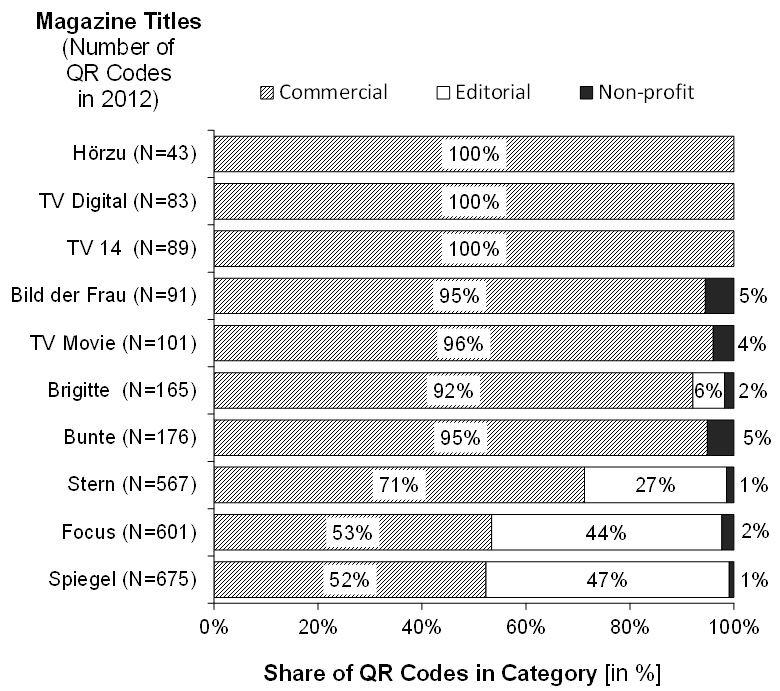 | Figure 3. QR Code Usage by Category and Magazine Titles |
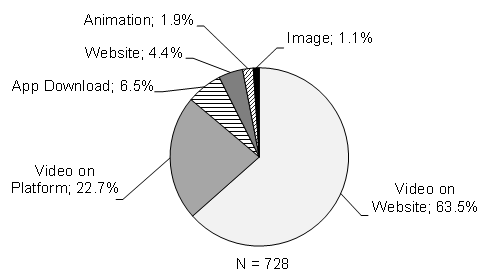 | Figure 4. Linked Content of Editorial QR Codes |
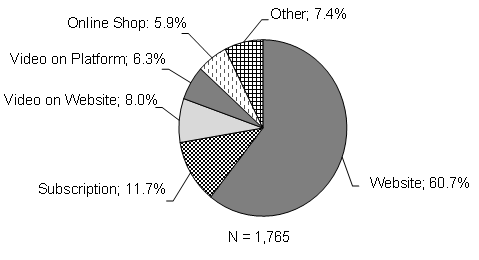 | Figure 5. Linked Content of Commercial QR Codes |
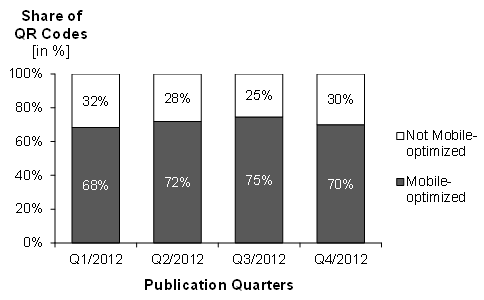 | Figure 6. Mobile-Optimisation of QR Code Targets |
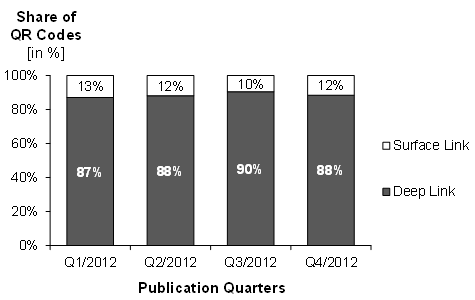 | Figure 7. Deep Links and Surface Links in the QR Codes |
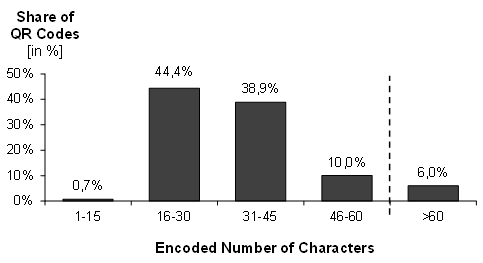 | Figure 8. Number of Characters Encoded in the QR Codes |
5. Conclusions
- In 2012, QR codes were already implemented comprehensively in the ten popular magazines with the highest turnover in Germany. Moreover, the frequency of use increased significantly over the course of the year. QR codes were mainly applied for commercial purposes; here mostly with reference to websites and homepages, although many other contents were linked via the mobile tags. An integration of QR codes for editorial purposes, however, was only implemented by a few magazines. Here, links were most frequently made to multimedia contents or video contents. 71 percent of the link targets were already optimised for mobile devices in 2012. Important best practice guidelines were also observed when integrating codes, which means that mostly deep links were used and the number of characters in the QR codes was kept to a minimum. The criteria mentioned above are, however, the essential basis for meaningful and successful use of QR codes, which means that if they are not observed to the full, room for improvement immediately occurs. In addition, it should be emphasised that most of the codes are linked to supplementary information. A more sophisticated integration in the direction of the aforementioned advanced customer acquisition and retention strategies or interactive mobile advertising is still rather rare. Thus it appears that the potential of QR codes to realise new cross publishing strategies has not yet been fully exploited.The study at hand gives some first insights on QR code usage in German popular magazines. However, some limitations of the study have to be considered when interpreting the results. Only one single year and a limited sample of magazines could be examined due to time and budget restrictions. In addition, insights on the perception and usage of the QR codes from the magazine readers’ perspective have not been analysed. For this reason, long-term analyses with larger samples and an inclusion of the user perception must be subject to further research.However, this is only possible if the appropriate data are made available by popular magazines and advertisers. Up to now, there are hardly any findings and only few data have been published on the response rates or effectiveness of QR code use [e.g. 14]. Thus the study at hand cannot answer the question whether the rising number of QR codes observed is caused by sustainable benefits for the publishing houses or is just a temporary result of a bandwagon effect whereby the omnipresence of the codes provokes imitators and an increasing usage by advertisers and publishing houses. This illustrates the need to establish effective usage and response tracking and share this knowledge in the industry to be able to provide benchmarks and to advance QR code usage in print media.
ACKNOWLEDGEMENTS
- The authors wish to thank the many students of the Media Management program of the RheinMain University of Applied Sciences who have supported the study and data collection over the year 2012. Parts of this article and study findings are also intended for publication in German language [31].
References
| [1] | G. Lawson‐Borders, Integrating new media and old media: Seven observations of convergence as a strategy for best practices in media organizations, International Journal on Media Management, 5(2), 2003, 91–99. |
| [2] | O. Aygoren and K. Varnali, Value-Based Analysis of Mobile Tagging in Mobile Applications and Knowledge Advancements in E-Business, I. Lee, Ed. IGI Global, 2012, 98–110. |
| [3] | O. Westlund, Mobile News, Digital Journalism, 1(1), 2013, 6–26. |
| [4] | B. W. Wirtz, Medien- und Internetmanagement. Gabler, Wiesbaden, 2012. |
| [5] | A. Veglis, Cross-media publishing by U.S. newspapers, The Journal of Electronic Publishing, 10(2), 2007, http://quod.lib.umich.edu/cgi/t/text/text-idx?c=jep;view=text; rgn=main;idno=3336451.0010.211, accessed: 28 Juli 2014. |
| [6] | J. Bjur, K. C. Schrøder, U. Hasebrink, C. Courtois, H. Adoni and H. Nossek, Cross-Media Use: Unfolding Complexities in Contemporary Audiencehood in Audience transformations. Shifting audience positions in late modernity, N. Carpentier, K. Schrøder and L. Hallett, Eds. Routledge studies in European communication research and education 1. Routledge, New York, 2013, 15–29. |
| [7] | S. Böhm and S. J. Niklas, Mobile Tagging in the German Market: A Comparative Study on User and Non-User Characteristics, International Journal of Business and Management Studies, 4(2), 2012, 161–170. |
| [8] | J. Z. Gao, L. Prakash, and R. Jagatesan, Understanding 2D-BarCode Technology and Applications in M-Commerce - Design and Implementation of A 2D Barcode Processing Solution in 31st Annual International Computer Software and Applications Conference - Vol. 2 - (COMPSAC 2007), 2007, 49–56. |
| [9] | K. R. Saint, Quick Response (QR) Codes and Practical Applications in Newspaper Publications, The University of Alabama McNair Journal, 13, 2013, 123–144. |
| [10] | E. S. Bayrak Meydanoglu, QR Code: An Interactive Mobile Advertising Tool, International Journal of Business and Social Research, 3(9), 2013, 26–32. |
| [11] | A. Eckhardt, Fricke, Jan René, and L. M. Weinhold (2013), Mobile-Tagging-Studie 2014. Eine empirische Studie mit den 1.000 größten Unternehmen und 50 größten Banken in Deutschland,http://www.is-frankfurt.de/fileadmin/user_upload/publicationsNew/Mobile-Tagging-Studie-2014.pdf, accessed: 13 Juli 2014. |
| [12] | S. Böhm, S. Niklas, and B. Haas, Vertrauen als Determinante der Technologieakzeptanz von Mobile Tagging in Vertrauenspotentiale im Internet. Technologieakzeptanz, Kundenkontakt, Informationsbewertung, T. Urban, Ed. Multimedia marketing & Kommunikation Bd. 3. Peter Lang, Frankfurt am Main, 2012, 1–33. |
| [13] | S. Rajendra and B. Hemant, QR Codes in Print Advertising: Elucidating Indian Vogue Using Content Analysis, Management & Marketing, 8(2), 2013, 353–368. |
| [14] | R. Matus, A. Carver and M. Tricca (2012). Mobile Activated Print in Magazine Advertising, Including QR Codes and Watermarks,http://www.nellymoser.com/wp-content/uploads/QR-Codes-in-Magazine-Advertising-Q2-2012.pdf, accessed: 4 July 2014. |
| [15] | Kommission zur Ermittlung der Konzentration im Medienbereich (2011), Publikumszeitschriften.http://www.kek-online.de/medienkonzentration/medienrelevante-verwandte-maerkte/publikumszeitschriften.html, accessed: 11 March 2014. |
| [16] | Informationsgesellschaft zur Feststellung der Verbreitung von Werbeträgern, Werbeträgerdaten - Quartalsauflagen. http://www.ivw.eu/index.php?menuid=37&reporeid=10#publikumszeitschriften, accessed: 11 March 2014. |
| [17] | Verband Deutscher Zeitschriftenverleger (2012),Präsentation zur Jahrespressekonferenz2012,http://www.vdz.de/fileadmin/vdz_de, accessed: 11 March 2014. |
| [18] | Verband Deutscher Zeitschriftenverleger (2013),Präsentation zur Jahrespressekonferenz 2013, http://www.vdz.de/fileadmin/vdz_de/, accessed: 11 March 2014. |
| [19] | M. Ebling and R. Cáceres, Bar Codes Everywhere You Look, IEEE Pervasive Comput., 9(2), 2010, 4–5. |
| [20] | D. Moth (2012), Eight Best Practice Tips for Using QR Codes in Marketing,https://econsultancy.com/blog/11054-eight-best-practice-tips-for-using-qr-codes-in-marketing, accessed: 13 March 2014. |
| [21] | Qfuse (2013), Best Practices for Making QR Codes Work with Your Marketing Materials,https://assets.hubexchange.com/qfuse/beta/v0781341724269/QRCodeBestPracticesQfuse.pdf, accessed: 13 March 2014. |
| [22] | H. Tolliver-Nigro (2013), QR Codes: Top 5 Best Practices. http://www.qslprinting.com/wp-content/uploads/QR-Code-Best-Practices.pdf, accessed: 11 March 2014. |
| [23] | J. Wheeler (2011), QR Code Best Practices for Print, http://www.themobilists.com/2011/10/11/qr-code-best-practices-in-print/, accessed: 12 March 2014. |
| [24] | QRStuff.com, What Size Should A Printed QR Code be? http://www.qrstuff.com/blog/2011/01/18/what-size-should-a-qr-code-be, accessed: 13 March 2014. |
| [25] | J. Schröder (2013). Umsatz-Ranking: die Top 50 der Magazine,http://meedia.de/2013/03/07/umsatz-ranking-die-top-50-der-magazine/, accessed: 26 June 2013. |
| [26] | TV Movie (2012). Trailerview App. Mit einem Klick zum Trailer! http://www.tvmovie.de/trailerview, accessed: 13 March 2014. |
| [27] | Axel Springer (2010), Axel Springer baut iKiosk-App weiter au,.http://www.axelspringer.de/presse/Axel-Springer-baut-iKiosk-App-weiter-aus_1501256.html, accessed: 13 March 2014. |
| [28] | Bild der Frau (2012), Leckere Rezepte – jederzeit: Die App "Kochen mit BILD der FRAU".http://www.bildderfrau.de/rezepte/rezepte-app-d33698.html, accessed: 13 March 2014. |
| [29] | TNS Infratest (2012), The Impact of Digital on Growth Strategies Digital Life: CMO Imperatives for 2012, http://www.tns-infratest.com/presse/pdf/The-Impact-of-Digital-on-Growth-Strategies_-_CMO-Imperatives.pdf, accessed: 14 April 2014. |
| [30] | ScanLife (2012), Mobile Barcode. Q1 2012 Trend Report, http://www.scanlife.com/assets/images/pdf/scanlife-trend-report-q1-2012.pdf, accessed: 4 July 2014. |
| [31] | S. Böhm and D. Ruthardt, QR Codes in Publikumszeitschriften: Eine Heftanalyse zu Anwendung und Trends im deutschen Markt in Handbuch Praxis Mobiles Internet, Hagen Sexauer and Florian Treiß, Eds. Denk!Institut, Königswinter, in press. |
 Abstract
Abstract Reference
Reference Full-Text PDF
Full-Text PDF Full-text HTML
Full-text HTML